Diving the HMS Hermes wreck in Sri Lanka
HMS Hermes was the world's first purpose built aircraft carrier, laid down in 1918 at Newcastle in the UK, launched in 1919, but due to delays and modifications was not commissioned until 1924. With a gross weight of 11,020 tonnes and length of 183m, and only able to accommodate 20 aircraft, she was small compared to subsequent aircraft carriers and after serving in the Far East station in the 1920 / 30s and being involved in various police actions related to Britain's interests in China, was put in reserve and became a training ship in 1937.
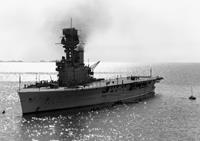 |
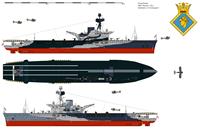 |
With the outbreak of World War 2 despite being somewhat obsolescent, she was put back into service and was involved in an action off Dakar, West Africa which caused significant damage to the Vichy French battleship Richelieu. Subsequently she was part of the Royal Navy Indian Ocean fleet, when the Japanese launched a surprise attack on Ceylon in April 1942. On news of the impending attack, she left the east coast naval port of Trincomalee without any aircraft on board in the company of an Australian destroyer HMAS Vampire and headed down the coast of Ceylon heading for safer southern waters. However she was spotted and attacked by dive bombers and fighters from Japanese aircraft carriers and was a sitting duck and together with HMAS Vampire was sunk about 10 km off the coast at Batticoloa in 53m of water within 15 minutes of the first attack with the loss of 307 lives out of a total complement of 556.
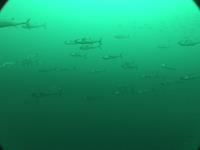 |
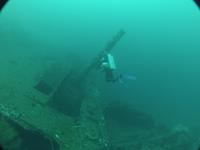 |
Although the position of the wreck was probably known by local fishermen, it was not discovered by divers until the 1960s, and again in an expedition in 1985. The subsequent civil war in Sri Lanka prevented further diving until 2009 when a Sri Lankan diver who had rediscovered it in 2002 began to offer dive trips to experienced divers. To date less than 300 divers have actually dived the wreck, which is unsalvaged and protected as a war grave.
Dives on the Hermes are slated for tec divers only, due to the depth, current etc. Feli from Sri Lanka Dive Tours (www.srilanka-divingtours.com) who rediscovered the Hermes in 2002 and has done over 700 dives on the wreck, is a nice guy, and also a qualified tec diving instructor who runs courses and trips from his rustic Deep Sea resort located on the coast at Batticoloa, the closest point to the wreck. There is a trainlng pool and equipment hire, Nitrox and oxygen available there. He has a small (takes up to 4 divers) fibreglass boat with 40hp out boat motor, which after exiting the bar of the lagoon takes about 20 minutes to reach the dive site. He can bring up to four other similar boats depending on demand from his recreational dive operation up the east coast at Trincomalee.
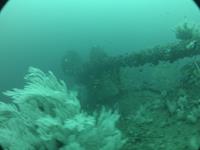 |
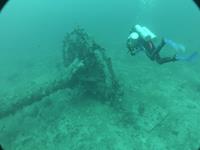 |
On the two days that I dived the Hermes the sea was calm, with only a light current running. After a backward roll we followed the anchor line down. The water was warm, around 27 degrees, and quite clear for the first 20m, the we hit a layer of darker water where the visibility reduced dramatically. At about 35m the water became clearer again and we could see the wreck about 10 to 15m below lying on the flat bottom. We were amidships and the Hermes was lying keeled over on her port side, with the highest point (40m) being the bilge keel. The island (superstructure) had collapsed across the sea bed, but the bridge and conning tower were intact and visible. One of the starboard 5.5inch guns was intact and sticking out from its armour in an upwards direction. Along the whole length of the vessel, the deck had collapsed from the bomb hits taken and perhaps time, however the hull was mostly intact, and had beautiful soft white fan coral growth in many places. During the four dives that I made we saw some of the other 5.5 inch guns, plus anti aircraft guns, the starboard twin bow anchors and chains, the stern twin screws with their shafts, the rudder, the almost intact bow, and even a row of toilet bowls through a gap in the hull. Scattered around on the sandy bottom close to the wreck were shells still in their boxes, and what may have been a torpedo looking device for cutting lines.
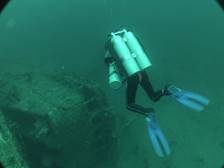
For the dives that I did, the light was gloomy on account of the dark layer above the wreck and the visibility was about 10 to 15m. Because of this and the age of the ship (designed during WW1) it felt a bit like diving the wrecks at Scapa Flow, although about the water was 15 to 20 degrees warmer! The fish life was impressive: on the wreck were some large moray eels, and floating above was an enormous school of juvenile snapper, but best of all on one of the dives probably between 50 and 100 large dog tooth tuna swam past. Bottom time was around 25minutes, and staged decompression lasted about 30 minutes, aided by the use of Nitrox and then oxygen at 6m. We did an early morning and mid day dive on both days, with a shore break in between.
As a stand alone wreck, the Hermes was one of the best that I have ever dived, and it is the only diveable aircraft carrier in the world, sunk by enemy action. There are other wrecks and recreational dives to be had on Sri Lanka. Diving on the east coast (where the wreck lies) is from April to October, and the west coast from November to March. Air Asia (via KL) offer the cheapest flights to Colombo from Australia.
September 2015
 South West of WA
South West of WA HMS Hermes
HMS Hermes